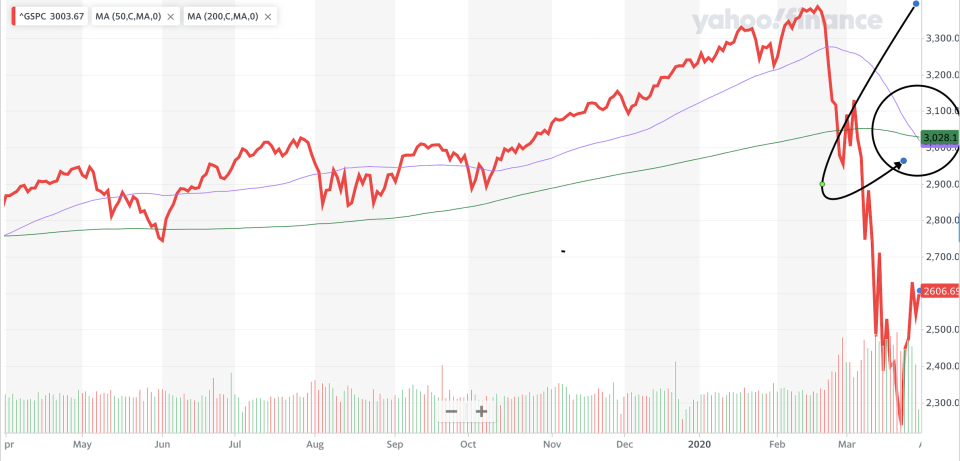Coronavirus stock market rally triggers the dreaded 'death cross'
The last thing beat-up investors want to see right now is an often dreaded technical formation in the markets.
Yet, that’s where we are after the S&P 500 has rallied hard off the lows achieved a week ago. For the first time in over a year, the S&P 500 is seeing its 50-day moving average cross below its 200-day moving average (see Yahoo Finance chart below) points out SunDial Capital Research. This is known on Wall Street as the “death cross,” and is commonly believed to be a bearish short-term indicator for markets.
Not all technical analysts are concerned about this pattern re-emerging.
“In terms of the moving average cross, there are so many other forces at play here, and the backdrop so historically complex, that I have not even considered the moving average cross a threat to risk appetite, but I imagine that if I am right and we V rally back to 2800/2950/3000, we will begin to run into overhead resistance around that cross and those averages,” explained Evercore ISI head of technical analysis Rich Ross via email.

But, SunDial Capital Research has the historical data handy to back up their concerns.
Going back to 1928, when the S&P 500 has formed a death cross in under 200 days the index has dropped a median of 2.9% over the next month. Some declines during the data set used have been severe, however. After the death cross formation hit on May 4, 1962, the S&P 500 went onto lose 13.1% in the next month. The death cross was triggered on Aug. 28, 2015 and the S&P 500 quickly 5.3% over the month.
If there is any savings grace here, the S&P 500’s median return one-year removed from the death cross being hit is 9.7% SunDial Capital Research data shows.
“The returns across stocks, sectors, and the S&P 500 index itself suggest that this is not a robust sell signal. If anything, it's the opposite over a medium- to long-term time frame. The only caveat is that quite a few of the recent signals saw a testing phase of the initial low, though that has become such consensus opinion right now, it seems unlikely for the market to accommodate so many similar opinions,” SunDial’s team writes.
Reassuring, we guess.
Brian Sozzi is an editor-at-large and co-anchor of The First Trade at Yahoo Finance. Follow Sozzi on Twitter @BrianSozzi and on LinkedIn.
Read the latest financial and business news from Yahoo Finance
Yum! Brands CEO on how his 50,000 restaurants are doing amidst the coronavirus pandemic
Grubhub founder: our sign-ups are surging during the coronavirus
HP CEO: here’s how we are helping coronavirus relief efforts
Follow Yahoo Finance on Twitter, Facebook, Instagram, Flipboard, SmartNews, LinkedIn, YouTube, and reddit.


